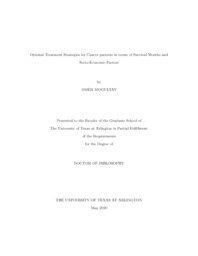
ATTENTION: The works hosted here are being migrated to a new repository that will consolidate resources, improve discoverability, and better show UTA's research impact on the global community. We will update authors as the migration progresses. Please see MavMatrix for more information.
Show simple item record
| dc.contributor.advisor | Shahriyari, Leili | |
| dc.contributor.advisor | Aktosun, Tuncay | |
| dc.creator | Mogultay, Omer | |
| dc.date.accessioned | 2022-07-14T15:56:13Z | |
| dc.date.available | 2022-07-14T15:56:13Z | |
| dc.date.created | 2020-05 | |
| dc.date.issued | 2020-05-29 | |
| dc.date.submitted | May 2020 | |
| dc.identifier.uri | http://hdl.handle.net/10106/30688 | |
| dc.description.abstract | One of the main challenges of cancer patients and their healthcare providers is making decisions regarding choosing the best treatment option. In the first part of thesis, we analyze breast cancer patients’ data to discover characteristics of patients who would benefit from each breast cancer surgical procedure in terms of increasing survival months.
Since the outcome of breast cancer treatments strongly depends on the tumor subtypes, several studies investigated the outcome of surgical procedures for each of these subtypes. On the other hand, it has been shown that the outcome of breast cancer treatments is significantly different between black and white patients. These treatment comparison analyses were mostly done using traditional statistical methods. Here, we integrate statistical methods and machine learning techniques to perform a comprehensive analysis and consider not only patients’ clinical data but also demographic information as well as gene expression profile of tumors.
To determine the optimal surgical procedure for each racial group of breast cancer patients with a given tumor subtype, we analyzed clinical and gene expression data sets of 1082 patients with breast invasive carcinoma. We used K-mean clustering with both clinical information and gene expressions to find the best treatment option in the intersections of data sets. We further investigated characteristics of patients’ tumors in each group by performing gene set enrichment analysis (GSEA). Our results indicate that the outcome of surgical procedures is a function of race, subtype of the tumor, and gene expression data of primary tumors. Importantly, we also found that radiation therapy have increased survival of white and black patients.
Although survival months is the main factor in making decision regarding cancer treatments, it is not certainly the only important factor. Cancer patients also think about the impact of cancer treatments on their quality of life and careers because of many factors, including side-effects and the cost of treatments. For example, the most common side-effect of cancer treatments is dizziness, which reduces the ability of patients in driving. This minor side effect might completely change cancer patients’ life if the only way to get to work is driving. The main goal of the second part of this thesis is to investigate the role of transportation in decision making of cancer patients and their quality of life. To reach this goal, we created a survey and utilize the recent advances in data science to analyze the collected data. We employed machine learning algorithms to identify the characteristics of patients who might benefit from free/discounted rides. | |
| dc.format.mimetype | application/pdf | |
| dc.language.iso | en_US | |
| dc.subject | Breast cancer | |
| dc.subject | Optimal treatment | |
| dc.title | OPTIMAL TREATMENT STRATEGIES FOR CANCER PATIENTS IN TERMS OF SURVIVAL MONTHS AND SOCIO-ECONOMIC FACTORS | |
| dc.type | Thesis | |
| dc.date.updated | 2022-07-14T15:56:14Z | |
| thesis.degree.department | Mathematics | |
| thesis.degree.grantor | The University of Texas at Arlington | |
| thesis.degree.level | Doctoral | |
| thesis.degree.name | Doctor of Philosophy in Mathematics | |
| dc.type.material | text | |
Files in this item
- Name:
- MOGULTAY-DISSERTATION-2020.pdf
- Size:
- 7.547Mb
- Format:
- PDF
This item appears in the following Collection(s)
Show simple item record


